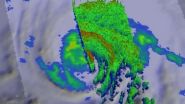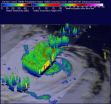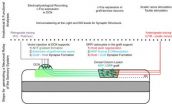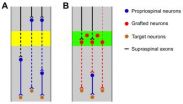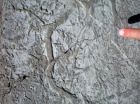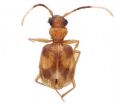(Press-News.org) When NASA's Aqua satellite passed over Typhoon Halong on its northern journey through the western North Pacific Ocean, it became wide-eyed again after going through eyewall replacement.
Eyewall replacement happens when the thunderstorms that circle the eye of a powerful hurricane are replaced by other thunderstorms. Basically, a new eye begins to develop around the old eye and it usually indicates a weakening trend.
The Moderate Resolution Imaging Spectroradiometer or MODIS instrument aboard Aqua captured a visible image of Halong on August 6 at 04:30 UTC (12:30 a.m. EDT). The image showed powerful bands of thunderstorms swirling into the center from the northwestern quadrant that wrapped entirely around the cyclone. The image shows the island of Okinawa hundreds of miles north-northwest of Halong's eye.
The day before, August 5, NASA and the Japan Aerospace Exploration Agency's Tropical Rainfall Measuring Mission (TRMM) satellite saw Typhoon Halong on August 5, 2014 at 1550 UTC (11:50 a.m. EDT). Halong was still a strong violent category 2 typhoon with winds of 85 knots (97.8 mph/57.4 kph). Rainfall derived from TRMM's Precipitation Radar instrument revealed that rain was falling at a rate of over 87 mm (about 3.4 inches) per hour south of the Halong's eye.
Also on August 5, subsidence, or sinking air was inhibiting the development of thunderstorms on the northern side. Today, there has been an increase in organization of the eyewall as a band of strong thunderstorms expanded in that northern quadrant.
On August 6 at 0900 UTC (5 a.m. EDT), Halong's maximum sustained winds were still at 85 knots ((97.8 mph/57.4 kph). Halong was centered near 23.4 north and 130.7 east, about 255 nautical miles (293.4 miles472.3 km) southeast of Kadena Air Base, Okinawa. Halong has tracked north-northeastward at 7 knots (8.0 mph/12.9 kph). Halong continues to create very rough seas with maximum significant wave heights at 35 feet (10.6 meters).
The Joint Typhoon Warning Center (JTWC) forecasts Halong to track over Minami Daitō Jima by August 7. The Daitō Islands are an archipelago made up of three isolated coral islands southeast of Okinawa. The forecast track from JTWC then carries Halong to a landfall in Shikoku by August 9. Shikoku is the smallest of Japan's four main islands. It is located south of Honshū. All of these areas are under weather advisories. For more information about advisories in Japan, visit the Japan Meteorological Agency's website at: http://www.jma.go.jp/en/warn/.
VIDEO:
NASA's TRMM satellite passed over Typhoon Halong on August 5 and revealed that rain was falling at a rate of over 87 mm (about 3.4 inches) per hour south of...
Click here for more information.
INFORMATION:
Text credit: Rob Gutro
NASA's Goddard Space Flight Center
Typhoon Halong opens its eye again for NASA
2014-08-06
ELSE PRESS RELEASES FROM THIS DATE:
Older adults have morning brains!
2014-08-06
Toronto, Canada – Older adults who are tested at their optimal time of day (the morning), not only perform better on demanding cognitive tasks but also activate the same brain networks responsible for paying attention and suppressing distraction as younger adults, according to Canadian researchers.
The study, published online July 7th in the journal Psychology and Aging (ahead of print publication), has yielded some of the strongest evidence yet that there are noticeable differences in brain function across the day for older adults.
"Time of day really does matter when ...
New hand-held device uses lasers, sound waves for deeper melanoma imaging
2014-08-06
WASHINGTON, Aug. 6, 2014—A new hand-held device that uses lasers and sound waves may change the way doctors treat and diagnose melanoma, according to a team of researchers from Washington University in St. Louis. The instrument, described in a paper published today in The Optical Society's (OSA) journal Optics Letters, is the first that can be used directly on a patient and accurately measure how deep a melanoma tumor extends into the skin, providing valuable information for treatment, diagnosis or prognosis.
Melanoma is the fifth most common cancer type in the United ...
Trapped: Cell-invading piece of virus captured in lab by SLU scientists
2014-08-06
ST. LOUIS – In recent research published in the Journal of Biological Chemistry, Saint Louis University investigators report catching integrase, the part of retroviruses like HIV that is responsible for insertion of the viral DNA into human cell DNA, in the presence of a drug designed to thwart it.
This achievement sets the stage to use x-ray crystallography to develop complete images of HIV that include integrase, which in turn will help scientists develop new treatments for the illness.
Duane Grandgenett, Ph.D., professor at SLU's Institute of Molecular Virology ...
Transplanting neural progenitors to build a neuronal relay across the injured spinal cord
2014-08-06
Cellular transplantation for repair of spinal cord injury is a promising therapeutic strategy that includes the use of a variety of neural and non-neural cells isolated or derived from embryonic and adult tissue as well as embryonic stem cells and induced pluripotent stem cells. In particular, transplants of neural progenitor cells (NPCs) have been shown to limit secondary injury and scar formation and create a permissive environment in the injured spinal cord through the provision of neurotrophic molecules and growth supporting matrices that promote growth of injured host ...
Relay strategies combined with axon regeneration: A promising approach to restore spinal cord injury
2014-08-06
For decades, numerous investigations have only focused on axon regeneration to restore function after traumatic spinal cord injury (SCI), as interrupted neuronal pathways have to be reconnected for sensorimotor and autonomic recovery to occur. Experimental approaches have ranged from drug delivery and cell transplantation to genetic manipulations. Certainly, it would be an extraordinary achievement for injured axons to regenerate over long distances, to form synapses with target neurons, and to result in dramatic functional improvement. Dr. Shaoping Hou from Drexel University ...
Exposure to inflammatory bowel disease drugs could increase leukemia risk
2014-08-06
Bethesda, MD (August 6, 2014) – Immunosuppressive drugs called thiopurines have been found to increase the risk of myeloid disorders, such as acute myeloid leukemia and myelodysplastic syndrome, a rare bone marrow disorder, seven-fold among inflammatory bowel disease (IBD) patients. These data were reported in a new study published in Clinical Gastroenterology and Hepatology, the official clinical practice journal of the American Gastroenterological Association (AGA). Thiopurines are an established treatment for IBD patients, used to reduce inflammation and provide symptom ...
Burrowing animals may have been key to stabilizing Earth's oxygen
2014-08-06
Evolution of the first burrowing animals may have played a major role in stabilizing the Earth's oxygen reservoir, according to a new study in Nature Geoscience.
Around 540 million years ago, the first burrowing animals evolved. When these worms began to mix up the ocean floor's sediments (a process known as bioturbation), their activity came to significantly influence the ocean's phosphorus cycle and as a result, the amount of oxygen in Earth's atmosphere.
"Our research is an attempt to place the spread of animal life in the context of wider biogeochemical cycles, ...
Skull shape risk factors could help in the welfare of toy dog breeds
2014-08-06
New research has identified two significant risk factors associated with painful neurological diseases in the skull shape of the Cavalier King Charles Spaniel (CKCS). The findings could help in tackling these conditions in toy dog breeds and could be used in breeding guidelines.
The study conducted by undergraduate student, Thomas Mitchell, from the University of Bristol's School of Veterinary Sciences, and supervised by Dr Clare Rusbridge, is published online in the journal Canine Genetics and Epidemiology.
Syringomyelia (SM) is a painful condition in dogs and is ...
Aggressive behaviour increases adolescent drinking, depression doesn't
2014-08-06
Adolescents who behave aggressively are more likely to drink alcohol and in larger quantities than their peers, according to a recent study completed in Finland. Depression and anxiety, on the other hand, were not linked to increased alcohol use. The study investigated the association between psychosocial problems and alcohol use among 4074 Finnish 13- to 18-year-old adolescents. The results were published in Journal of Adolescence.
The results indicate that smoking and attention problems also increase the probability of alcohol use. Furthermore, among girls, early menarche ...
A synopsis of the carabid beetle tribe Lachnophorini reveals remarkable 24 new species
2014-08-06
An extensive study by Smithsonian scientists presents a synopsis of the carabid beetle tribe Lachnophorini. The research contains a new genus and the remarkable 24 new species added to the tribe. The study was published in the open access journal ZooKeys.
Beetles from the family Carabidae, commonly known as ground beetles are a large, cosmopolitan group, with more than 40,000 species worldwide, Carabid beetles range in size from 0.6 mm to 90.2 mm and occur in nature in several fractal universes influencing life therein as predators, ectoparasitoids, seed eaters, and even ...
